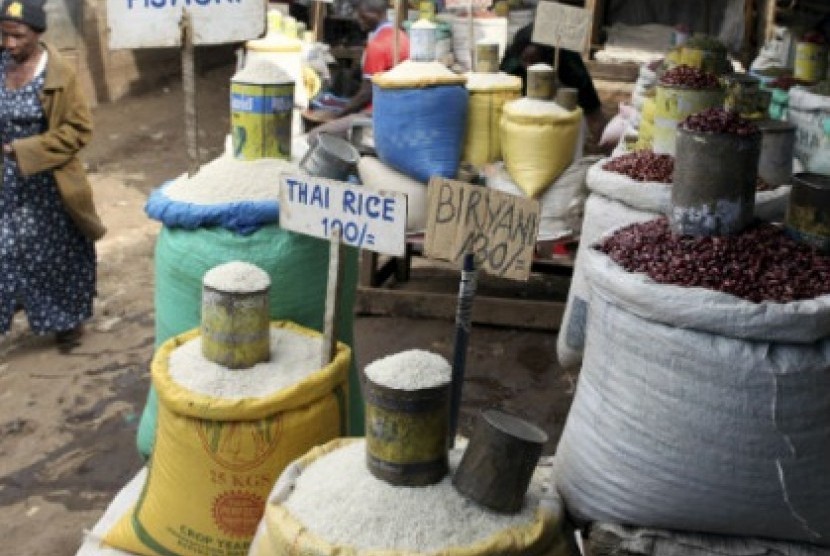REPUBLIKA.CO.ID, NAIROBI -- Street food vendors in suburbs in Nairobi, Kenya's capital, are doing brisk business as the cost of living rises in the East African nation.
Many families in the capital are buying food from the vendors as they seek to cut costs associated with making meals at home.
The rise in demand for street food has seen the number of people engaging in the trade increase.
The foods the vendors are preparing include githeri (a mixture of beans and maize), beans, chapatis, doughnuts, fries, porridge, vegetables and ugali (corn meal).
While some people eat the foods at the traders' premises, most families buy and go into their homes to prepare them better.
Jane Ngatia is one of the many street food vendors in Nairobi who is making a killing from the business. Ngatia has been in the business for close to two years and she has seen it grow as demand rises.
"Business is good," Ngatia, who is based in Komarock on the east of the capital, said on Friday. "All the food I cook everyday is bought by residents. Demand is high; sometimes I am not even able to satisfy the market."
The mother of four mainly cooks githeri and beans, which are fast moving. "Most families come to buy githeri or beans at lunch time. The two are the most popular and it is the reason I stopped cooking other foods."
At her roadside kitchen, Ngatia only boils the foods. Therefore, families that buy them can go and prepare them better.
"If I boil and then fry, people may not like the way I do it because they have preferences, for instance, some may want to add in Irish potatoes or various spices," she explained.
The businesswoman sells githeri at 0.28 U.S. dollars a cup. On the other hand, beans go for 0.22 dollars a cup.
"Some people come and buy even up to five cups of either githeri or beans. Demand is normally high from Fridays throughout the weekend when most families are at home," said Ngatia who on a good day makes up to 30 days.
Of the two foods, according to her, githeri is the most popular among residents.
"Some families buy up to 10 cups of githeri and then go and store in refrigerators. They will then be picking from there and frying before they eat. It makes work easier."
Ngatia acknowledged that one of the reasons why her business is booming is the rising cost of foods in the East African nation.
A 90kg bag of beans is being sold at between 72 dollars and 82 dollars while a bag of maize is going for an average of 36 dollars. This is a rise of at least 2.3 dollars for both cereals.
Buying the two grains in packages of 2kg tins, as most families do, raises up the cost. A 2kg tin of maize is going at an average of 1.03 dollars while a 2kg tin of beans at 1.8 dollars.
Therefore, street food becomes a cheaper option for most families. "They will not have to take time cooking the meals, which increases the cost as one would have to buy fuel," said Ngatia, adding that it is cheaper for her because she cooks in bulk.
The same scenario is replicated on wheat products like chapati and doughnuts. With a 2kg packet of wheat going at 1.7 dollars and the foods taking time to prepare, families save costs when they buy the foods from the streets.
Until recently, buying foods from the streets has been associated with low income earners, particular in the slums. But that practice is spreading in Nairobi to middle-income settlements.
A 2011 study by the African Population and Health Research Center found that most families in Nairobi's low income settlements consume street food at least once a day.
The main reason families were engaging in the practice was due to high prices.
"Food insecurity is pushing families to street food, which although cheaper, is unhygienic and poses great health risks to residents," said the research done in Korogocho and Viwandani.
Prices of foods prepared on the streets in some slums, where the practice started, range from 0.11 dollars, for instance for githeri and fries to 0.5 U.S. dollars for beef and ugali.
As in middle-income areas, residents find the foods pocket- friendly since one can buy any portion they want depending on the amount of money they have.
"I sell up to 200 chapatis at 0.11 dollars each in a day. Some families buy them for breakfast while others for lunch or supper," said Gilbert Bosire, who prepares the food in Rongai, on the outskirts of Nairobi.
Food prices in Kenya are on the rise, pushing many families to the edge as inflation rises to 7.3 percent, up from 6.4 percent.
Equally, prices of fuel remain high, making cooking at home unattractive to many families.
While buying foods on the streets saves costs, nutritionist Janet Musunga warns against the habit, noting that the food may be unhygienic as some vendors may not handle it properly as they seek to satisfy rising demand.


